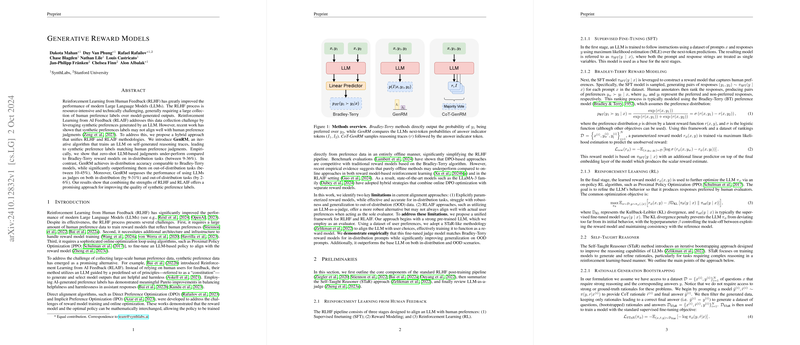Generative Reward Models: A Hybrid Approach in RLHF and RLAIF
The paper "Generative Reward Models" proposes a novel approach to improve the alignment of LLMs with human preferences by integrating Reinforcement Learning from Human Feedback (RLHF) with Reinforcement Learning from AI Feedback (RLAIF). This hybrid methodology introduces Generative Reward Models (GenRM) as a more efficient and potentially more effective mechanism for refining LLMs compared to traditional methods.
Core Contributions
The paper identifies key limitations in existing RLHF and RLAIF models and addresses these through a comprehensive framework that leverages a hybrid approach. The researchers introduce GenRM, which emphasizes self-generated reasoning traces to improve the reliability of synthetic preference labels. This is achieved by employing an iterative algorithm that blends human and AI feedback methodologies, providing a robust alignment mechanism for LLMs.
- Iterative Training with RLAIF: The paper leverages LLM-generated synthetic preferences, offering a path to circumvent the challenges associated with large-scale human data collection. By integrating self-taught reasoning within this paradigm, the authors provide a means to enhance the decision-making process of LLMs effectively.
- Improved Generalization: Empirically, GenRM demonstrates significant improvements in handling out-of-distribution tasks, outperforming traditional models such as Bradley-Terry on such tasks by 10-45%. It achieves this while maintaining comparable performance on in-distribution tasks, thus highlighting enhanced generalization capabilities.
- Rationale Bootstrapping: The paper also explores the role of rationale generation, showing that the model’s capabilities can be improved even when strong ground-truth rationales are not available, by utilizing post-rationalization techniques.
Methodological Advances
The proposed Generative Reward Models emphasize the integration of Chain-of-Thought (CoT) reasoning to guide preference modeling. This approach enables the LLM to produce more coherent and nuanced judgments by considering intermediate reasoning steps, thus aligning more closely with human evaluative processes.
- Self-Taught Reasoning: Adopting a Self-Taught Reasoner (STaR) methodology allows for iterative training where LLMs refine their outputs by generating and filtering through reasoning chains. This self-bootstrapped approach is shown to significantly improve both reasoning and non-reasoning tasks.
- Preference Optimization: The application of Direct Preference Optimization (DPO) within the context of GenRM enables these models to more effectively discern and align with human-like judgment patterns without the need for extensive online optimization processes.
Implications and Future Directions
The implications of this research are manifold, offering practical advancements in how AI feedback systems are structured and implemented. The results suggest promising avenues for reducing the dependency on human-annotated data by optimizing synthetic feedback systems, thereby streamlining the alignment process for LLMs.
- Scalability and Efficiency: By minimizing reliance on human data, this framework enhances scalability, making it feasible to apply in diverse and dynamic environments. The reduction in resource intensity also suggests potential cost efficiencies in deploying such systems.
- Improved AI Alignment: The hybrid model's ability to generalize better across varied tasks implies it could serve as a foundational approach in broader AI alignment challenges, particularly in scenarios requiring rapid adaptation and deployability across various domains.
Future research could explore further refinements in rationale generation and validation, perhaps by incorporating even more sophisticated heuristic or neural-based corrections to refine judgment accuracy. There's also room to investigate the integration of multi-modal data and enhance robustness against adversarially constructed prompts.
In summary, the introduction of Generative Reward Models marks a significant contribution to the landscape of LLM training, presenting a method that balances efficiency with reliability, paving the way for more adept and responsive AI systems.
